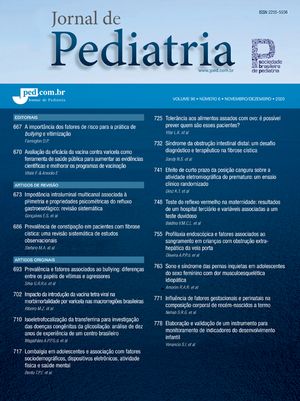
To present current concepts about the diagnosis of recurrent abdominal pain and to review the basis of the therapeutic approach for this disease in children and adolescents.
MethodsReferences were obtained from the Medline, from recent review articles, and from personal files. Books and dissertations were also analyzed. Only the most important articles were included in this review.
ResultsRecurrent abdominal pain is the main cause of recurrent pain in children between 4 and 16 years of age. It is defined as the occurrence of three or more abdominal pain attacks within 3 months or less. These attacks are severe enough to interrupt routine activities, making the child remain asymptomatic between the episodes of pain. The diagnosis is based on a detailed clinical history, on an improved physical examination, and on a few laboratory tests. It can be manifested with isolated paroxysms of umbilical pain, abdominal pain with dyspeptic symptoms, and abdominal pain with digestive tract dysfunction. The treatment must emphasize the cognitive-behavioral factors of the recurrent pain.
ConclusionsThe treatment of recurrent abdominal pain using the strategy presented here represents an equilibrium in which time is neither wasted nor insufficient during the investigative process required for treating children and their families with this problem.
Apresentar conceitos atualizados do diagnóstico e revisar as bases da abordagem terapêutica da dor abdominal recorrente em crianças e adolescentes.
MétodoForam obtidas referências na Medline, em artigos recentes de revisão e em arquivos pessoais. Também foram utilizados capítulos de livros e teses sobre o assunto. Foram citados apenas os artigos de maior relevância.
ResultadoA dor abdominal recorrente é a principal causa de dor crônica em crianças entre 4 e 16 anos de idade. É definida como a ocorrência de três ou mais ataques de dor no abdome, em período não inferior a três meses, graves o suficiente para interromper as atividades cotidianas, sendo que entre episódios dolorosos a criança mantém-se assintomática O diagnóstico baseia-se em uma história clínica detalhada, exame físico aprimorado e poucos testes laboratoriais. Pode se manifestar com paroxismos isolados de dor periumbilical, dor no abdome com dispepsia e dor abdominal com disfunção do tubo digestivo. O tratamento deve enfatizar os fatores cognitivo-comportamentais da dor recorrente.
ConclusõesA abordagem da dor abdominal recorrente visa a alcançar o equilíbrio, não perdendo tempo desnecessário, nem queimando etapas no processo de investigação e de tratamento dessa entidade.








